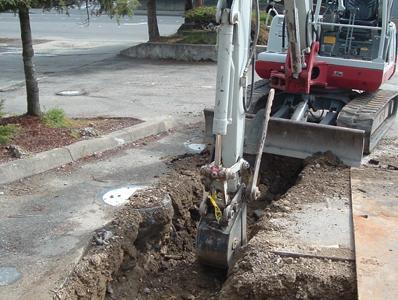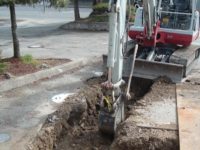Investigation results indicated the presence of PCE in soil at concentrations approaching 10,000 milligrams per kilogram, and in groundwater at concentrations exceeding regulatory cleanup criteria at depths from 50 to 100 feet below ground surface and extending off the site. Farallon collaborated with the Washington State Department of Ecology, the Kitsap County Health Department, the City of Bremerton, and several landowners to evaluate potential risks associated with the presence of PCE and to complete the site investigation and remedial feasibility testing required to develop an effective cleanup strategy.
Although unexpected bankruptcy of the insurance carrier funding the site investigation and cleanup caused project delays, Farallon assisted client and counsel in obtaining coverage through the Washington State Guaranteed Fund, enabling cleanup work to resume. Farallon next performed field-scale pilot testing to assess the feasibility of various remedial technologies deemed appropriate for site conditions, including soil vapor extraction (SVE), air and ozone sparging, and natural attenuation.
In 2008, Farallon installed an SVE and ozone sparging system as an interim action to treat the source areas of PCE contamination in soil and groundwater at the site. The system includes multi-level SVE wells designed to maximize PCE removal in the vadose zone, which is up to 50 feet thick. Approximately 270 pounds of PCE has been removed from the subsurface since start-up of the SVE system in August 2008.
To treat affected groundwater both at the site and in a limited area off site, Farallon installed an ozone sparging system. Incorporating ozone into a sparging system has the potential to cost effectively increase cleanup action efficiency and shorten the cleanup time frame. The ozone-sparging system was designed by Farallon to be used also for air sparging at higher injection pressures, enabling remediation beyond the ozone sparging radius and maximizing off site cleanup after the highest concentrations of PCE has been removed from groundwater at the site. Another system feature is multi-level sparge points that treat groundwater from approximately 50 to 100 feet below ground surface. Performance groundwater sampling has demonstrated decreasing concentrations of PCE in groundwater samples collected from on- and off-site monitoring wells since the August 2008 start-up of the ozone sparging system.
Farallon continues to monitor the cleanup rate for soil and groundwater and to evaluate whether further action is required to complete the cleanup. System operation will continue until site cleanup has been confirmed.

